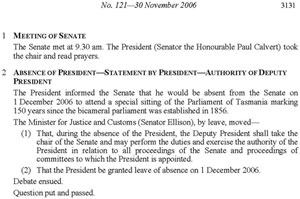13 Absence of President
-
When the Senate at the commencement of a sitting is informed by the Clerk of the absence of the President, the Deputy President shall perform the duties and exercise the authority of President in relation to all proceedings of the Senate until the next meeting of the Senate, subject to any order of the Senate.
-
If the Senate adjourns for more than 24 hours, the Deputy President shall continue to perform the duties and exercise the authority of President for 24 hours only after the adjournment, unless the Senate otherwise provides.
Amendment history
Adopted: 19 August 1903 as SO 29 (corresponding to paragraphs (1) and (2))
Amended: 22 October 1981, J. 589–90 (change of title of office)
1989 revision: Old SO 29 restructured as two paragraphs and renumbered as SO 13; language simplified
Commentary

Extract from the Journals of the Senate dealing with an absence of the President
Provision for the Deputy President (or Chairman of Committees) to act as President when the latter is absent on a sitting day reflects universal practice in legislatures where there is such an office, regardless of its designation. As paragraph (2) of the standing order suggests, the practice is designed to cover temporary absences only. Longer absences are otherwise provided for by resolution of the Senate.[1] The practical substance of the standing order has remained virtually unchanged since its adoption, without debate, in 1903.
Its operation, as recorded in the 1938 MS, also continues virtually unchanged:
When the President is absent, the bells are rung as usual for five minutes, and at the time appointed for the meeting the bells are switched off and the Clerk, in his place at the Table, informs the Senate of the unavoidable absence of the President, and that the Chairman of Committees will take the Chair as Deputy–President. This having been done, the Usher of the Black Rod enters the Chamber and announces the Deputy–President, who there upon enters the Chamber, takes the Chair, and reads Prayers.
The only difference is that the Clerk announces that the Deputy President will take the chair, without reference to the office of Chairman of Committees. This is in recognition of the nomenclature changes effected in 1981.[2]